Revell (Monogram) 1/48 F-84E Thunderjet
The war the fighter-bombers engaged in during the Korean War was a bloody one, a war unrelieved by opportunities for the kind of public acclaim the Sabre pilots received. Writing in “Officers in Flight Suits, The Story of American Air Force Fighter Pilots in the Korean War,” author John Darrell Sherwood stated:
"The life of a fighter-bomber pilot was hazardous and often short. Typically, fighter-bomber pilots flew lower-performance planes and exposed themselves daily to more hostile ground fire than the typical fighter-interceptor. Overall, only 147 Air Force planes were lost in air-to-air combat; by comparison, over 816 planes were shot down by ground fire. As Raymond Sturgeon, a pilot with the 35th squadron of the 8th Group, put it, ‘I had friends in 86s who never saw a MiG their entire tour, but we got fired on every mission with high-powered guns that shot golf balls at you.' Sturgeon's squadron lost ‘a pilot or two' every week, and losses like these were not unusual. Perrin Gower, another pilot in Sturgeon's squadron, claimed that five of the ten pilots he shared his hut with were killed, and Howard Heiner, a pilot in the 12th Squadron of the 18th Wing, remembers one week when seven pilots in his squadron were shot down.
In addition to the difficulties of life as a fighter-bomber pilot during a mission, life on the ground was only better in that one was not being shot at. One pilot of the 8th group recalled life at Suwon in the winter of 1951-52: “We lived in Quonset huts that had never been painted and had no insulation or covering of any kind on the inside walls; all you saw or felt was the cold, corrugated steel. There was one flight of four pilots to a hut. The hut was heated with fuel oil furnaces made of 55 gallon fuel drums, two of them in each hut. We slept on canvas Army cots with lots of blankets. The only women on base were either Korean or a few nurses. The nurses had their own hut of course, inside a fenced-in compound with one other house that was used by the group commander and hospital commander. The bath house sat off by itself about 100 yards from our hut (we were the closest) and it had the commodes too. There was nothing like taking a hot shower and then running 100 yards through snow and zero degree weather to get back to your warm hut.”
By the summer of 1951, the F-84 Thunderjet was the most important fighter-bomber type used by the Air Force in Korea. In June 1951, the 49th Fighter Bomber Wing handed over its Shooting Stars to the 8th wing and began converting to F-84E Thunderjets once the Air Force had approved the transfer of 75 F-84s to Korea. The Thunderjet force continued to grow. The 136th FBW, an Air National Guard unit from Texas, had arrived in Korea in May. They were followed by the 116th FBW, composed of squadrons from the Georgia, Florida and California Air National Guard in July. Strategic Air Command regained control of the 27th escort wing, following their departure from Korea at the end of June; before they left, the 27th provided transition training for the 49th wing and operational training for both the 49ers and the pilots of the 136th wing.
On September 19, 1951, 16 F-84E "Thunderjets" from the 9th Fighter Bomber Squadron of the veteran 49th Fighter Bomber Group were headed north from their base at Taegu (K-2) at 12,000 feet, each airplane loaded with two 500-pound bombs. The 9th FBS, alongside sister squadrons the 7th and 8th, were briefed to dive bomb the main rail line between Sinanju and Pyongyang at a "choke point" just south of Sukchon where the line went through a marshy area between two hills, making it the most difficult place for the enemy to make repairs. The target was right in the middle of MiG Alley.
Leading the 9th's Purple Flight was Major Willie Williams, the squadron commander. One of the most experienced pilots in the 49ers, Williams had joined the 49th shortly after the Inchon landings in September 1950. Williams' element leader, Purple Three, was Major James F. Sprinkle, with Captain Kenneth L. Skeen, the 9th's new squadron executive officer, flying his third F-84 mission as Sprinkle's wingman, Purple Four. Williams recalled, "We had transitioned to the Thunderjet by late August, and had been back in Korea for about a week at the time of this mission."
As the Thunderjets crossed the bomb line north of the Main Line of Resistance along the 38th Parallel, the weather changed from the clear skies in the south to broken clouds that became a heavy undercast by the time the 48 F-84Es passed east of Pyongyang. "I heard the group commander call out MiGs above us at seven o-clock, and saw the contrails. I told the rest of the squadron not to pickle their bombs if they made a pass on us unless it was life and death. At our altitude, the MiG was not that good, and I was pretty sure we could turn away from them with our ordnance. I knew they wouldn't stick around that low with 48 of us wanting to take a crack at them." While the MiG-15 had demonstrated its superiority over the Thunderjet in air-to-air combat, with an experienced pilot in the cockpit the big Republic fighter could hold its own at lower altitudes against the lesser-trained Communist pilots. By the fall of 1951, the 49th Fighter Bomber Group was a collection highly experienced flyers, with most pilots having flown at least 50 combat missions.
"I watched the MiGs above us, and saw them head down. They were coming right after the four of us in the lead, so I very reluctantly called for Purple Flight to salvo their bombs. I broke hard to the right as I saw them set up on their firing pass and they overshot. I reversed the turn to the left, and saw Ken Skeen pulling up high to my left and falling behind as I came around into the MiGs before they could get away to set up another pass. I got off some shots at two of them, and then warned Jim Sprinkle that he had one on his tail. Suddenly the MiG on Jim's tail caught fire and was trailing smoke. Then Ken Skeen called to break right, because I had another one on me. Ken had shot the one on Sprinkle's tail, and he kept at it till it blew up."
While the mission was unsuccessful, inasmuch as the MiGs had managed to catch The 49ers without their Sabre escort, forcing them to jettison all bombs in the melee that resulted, there was an appropriate celebration back at Taegu that night, since Skeen had scored the group's first MiG kill with the F-84. "The next day, I had each airplane in the 9th painted with a red star to celebrate that kill. It became part of the squadron insignia for the rest of the war."
By November 1952, Williams had flown 300 missions in two years, the equivalent of three complete tours, but had no plans to leave. "I knew Don Blakeslee, and I knew how he had doctored his books in England during World War II, listing any mission that didn't contact the enemy as a training flight, any mission flown with another unit as orientation, things like that. I did the same thing myself. I know it may not sound particularly right, but the flying we were doing in Korea was very satisfying to me and I didn't want to stop."
By the end of the Korean War in July 1953, Willie Williams was the high-time Air Force pilot of the war in terms of missions flown and hours logged over the course of nearly three years of combat flying. Looking back on two years of combat in the Thunderjet, Williams liked the airplane. "It was a maintenance hog, and the TBO on the engine was horrible until we got to the G-model. Everything you've ever heard about the airplane taking every inch of runway to get airborne is true. But as far as jets were concerned, it was about as rugged as the old Thunderbolt. We got chewed up by flak, and by MiGs, and brought them home with some pretty big holes in them. The ground crews managed to put them back together and they kept on flying. I never knew a pilot who didn't think the Thunderjet would get him home as long as the wing hadn't been shot off."
I had the privilege of knowing Willie Williams out at Planes of Fame during the 1990s. This model of "L'il Butch" of the 9th Fighter Bomber Squadron of the 49th Fighter Bomber Wing was one of the F-84Es he flew in Korea.
Monogram originally released the F-84G in 1999 in the ProModeler line. The F-84E was released in 2002. Comparing the Monogram Thunderjets with the Tamiya kit, the Monograms come out on top. They are easier to build, since you don't have to fiddle with closing up the gun bay in the nose (the part doesn't fit closed without a lot of fiddling) and the outline shape is more accurate, with the Tamiya fuselage being just too deep to be noticeable. Did I mention that the Revell-Monogram kit, at around $22, is a lot cheaper than the Tamiya? There were a lot of decals for Thunderjets released by Aeromaster and Cutting Edge, and you can still find them on eBay at decent prices. This model was finished using an Aeromaster sheet.
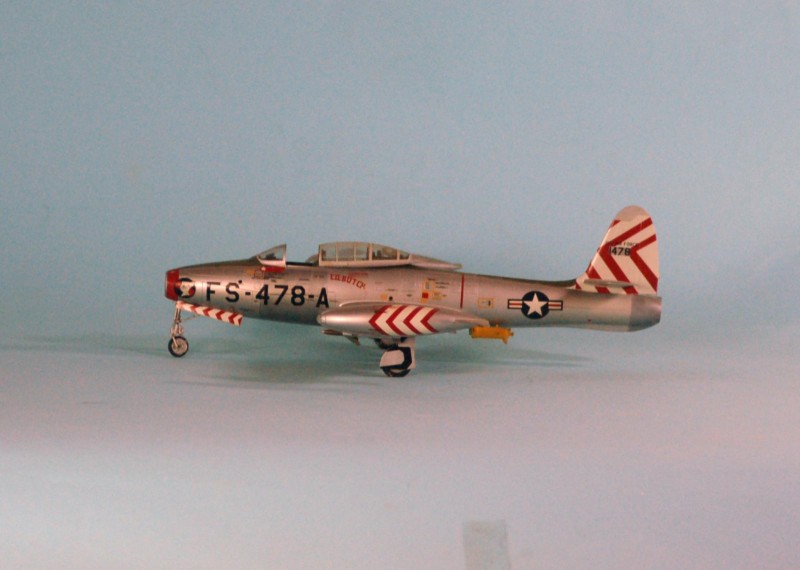
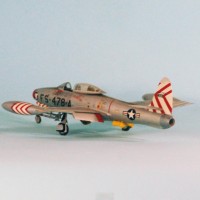
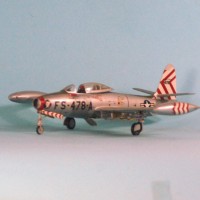
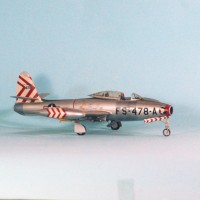

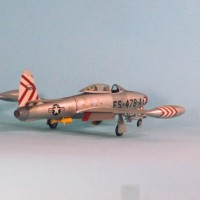
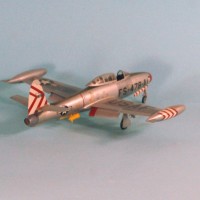
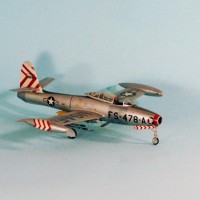
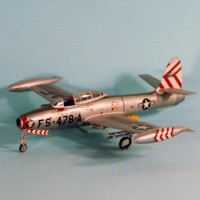
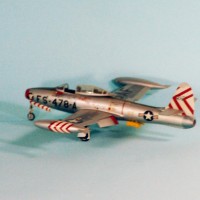
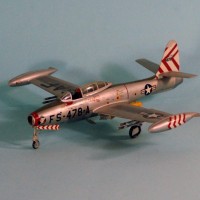
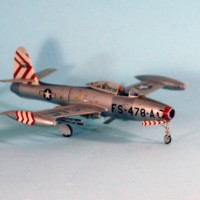
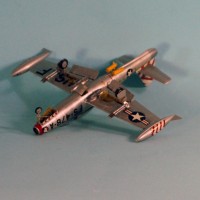
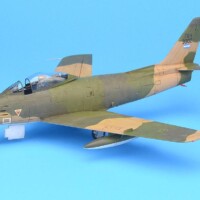
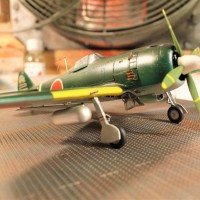
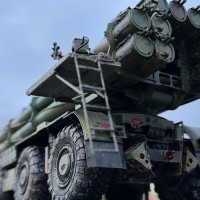
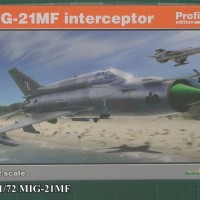
Dunno what there is about it, but I can tell your stuff as soon as I see it (go figure).
Nice build - and presentation - as is the norm.
Hello Tom.
I appreciate the story line behind this build. Here's why:
My dad had a childhood friend who ended up flying F-84's in Korea. His name was Mike Rebo
also seen standing near a T-6 in this next photo:
and he was shot down and killed by a Mig-15, on November 10th, 1951, that was flown by a Russian pilot named Captain Pavel Milauszkin, who flew with the 176 IAP / 324 IAD and he scored 10 kills in 1952.
This actual plane is included in this decal set from Aero Master that I have in the stash.
The Mig he was flying the day he shot down Lt. Rebo, was wearing North Korean markings and was numbered "758" on the nose. It was not widely known that Russian pilots were flying against the Americans on occasion, but they did.
Lt. Mike Rebo was listed as MIA / presumed killed in action for many years after the "Cease Fire" in 1953 was enacted. About 10 years ago, Mike's immediate family was contacted by the US Government, to provide a DNA sample.
A few years ago, the family was again contacted by a US Government agency in Hawaii, telling them that some of Mike's remains had been repatriated, and that he was finally coming home.
The first time I heard about this was when my Dad told me a story about how there were "Russians" flying in Migs over Korea. (This would have been in the early 1990's). I didn't believe Dad at the time and asked him how did he know this for sure...
Dad's reply was blunt and to the point, (and not very PC by today's standards). Dad said that he never saw a "G@@k" with blonde hair, alluding that he helped recover a Soviet pilot's body at some point during the War.
Anyhow I plan on building Mikes plane, which was an F-84 E, Serial number 51-549, and the one that shot him down in the near future, using the kit in the top of this photo. I think it's the same kit as yours.
I'll use a Tamiya Mig -15 as Pavel's plane.
Here's a short excerpt from an article I found online:
LOCATION OR BATTLE ZONE: NORTH KOREA
TOWN OR AREA: NEAR PYONGYANG
Comments: First Lieutenant Rebo was the pilot of a F-84E Thunderjet fighter with the 9th Fighter-Bomber Squadron, 49th Fighter-Bomber Group. On November 10, 1951, while on a combat mission, his flight of 12 F-84s was attacked by an enemy flight of 24 MiG-15s 30 miles southwest of Pyongyang, North Korea. He was listed as Missing in Action and was presumed dead on December 31, 1953. His family knew him as "Mickey."
Thanks for sharing this story with us. For me it has a very personal connection.
Another TC classic of giving a great history lesson, weaving personal stories of pilots who at great personal costs do their job. Some of them not making it , others being captured and held for the duration or through skill and dumb luck and the green glow manage to survive to tell the story. At times the articles themselves stand alone and then when you add the plastic it makes the kit that more relevant to the story and modeling in general.
Had Promodeler/Monogram gone onto produce kits like the F-84 they'd still be in business. Good solid engineering, some neat details and value for the money spent. Kind of what the new Airfix is doing.
The one niggle I found with my sample, is the insert that goes into the nose for the E model vs the G model insert which has the engine inlet door...I could never get it to sit flush and had to use some filler. Either the right of left fuselage was a little warped. Minor annoyances its a solid kit.
The Soviets didn't just fly "on occasion" during the Korean War. From November 1950 to October 1951, they were 100% of the MiG pilots the UN pilots faced. Even when the Chinese started flying combat in October 1951, it was never more than a regiment at a time until late 1952, and by 1953, the Chinese were flying about 60% of the missions (likely why USAF scores went up from November 1952 to the end). Overall, Soviet pilots flew a good 75% of total missions by the communists during the war. The three top-scoring aces of the war are all Russian. The MiGs so defeated the US bombing campaign that they drove the B-29s to night-only missions after October 1951 when they inflicted the greatest - percentage of total formation - losses on the USAF ever on october 19, "Black Thursday" - as one American said, "The Russians accomplished what the Germans never did - they stopped us." By mid-1952, the USAF couldn't fly fighter-bomber missions beyond the Chongchon River in "MiG Alley" without taking prohibitive losses.
And that "10-1 kill ratio" the Sabres had? HAH! And HAH! again. During "the year of the Honcho" in 1951, the Russians and Americans fought each other to a 1:1 draw, and overall, the Sabres probably had a 2:1 victory/loss ratio over the war. And that was adding in the Chinese. Against the Soviets, the score was more like 1.2:1 in the Sabre's favor. In the USAF, if an airplane was shot up in combat but made it back to the base, even if it crashed on landing or never flew again because of the damage inflicted, it was listed as a "non-combat" loss. Since the Soviet records became available after 1991 (though that access has been shut off since 2010), it's been clear to researchers that the USAF records are completely untrustworthy.
I just got finished writing "MiG Alley: the USAF in Korea," which will be out fall of 2019, and came away with the conclusion from my research and reading what other experts have found, that the Russian records are more accurate than the American! Shocking I know, it sure shocked me.
As to your father having found a Soviet pilot during the war, that's unlikely. So far as the records show, there was only one Soviet pilot who baled out over Korea and he shot himself thinking the Chinese troops coming for him were Korean guerillas. They were severely restricted on where they could fly operationally, to limit the possibility of this happening. That said, the USAF listening service had lots of proof of Russian being spoken on the air defense circuits from mid-1951 on.
I'm glad to hear your father's friend was recovered.All the research I found working on the book indicated that the F-80s and F-84s took a real beating. Oh, and the radar-guided AA was also operated by Soviet troops.
After writing The Frozen Chosen, and the to-come "Holding the Line: Naval Aviation in the Korean War" and "MiG Alley," I'm convinced that most of what people "know" about the Korean War is fantasy at best.
Thanks for the reply, and for shedding light on just how involved the Soviets were with flying Migs, and Air Defense. I didn't know that they flew as many missions as you indicated. I learned something there... as far as the statistics go, that doesn't surprise me either.
As far as what my Dad told me, unfortunately I can't confirm exactly what he said, he's been dead for 6 years now... He did tell me on several occasions about the Russians flying though.
I may have gotten some of it wrong since a lot of time has elapsed since then, (the early 1990's), and time can affect one's memory. He never said the Russian pilot he mentioned was alive, and I'm guessing that he could have been part of some Mig-15 wreckage. Dad told me that the Russian's were ordered to take their own life if there was even a slightest chance of the pilot falling into captivity. Moscow didn't want that...
Dad also told me how the Russian pilots were only supposed to be flying within a certain area, but that on occasion they would stray unintentionally during combat, and that they were often heard talking in their native Russian language on the radio when they became really excited.
I also remember Dad telling me about that if a plane of ours was downed near the forward areas, (behind enemy lines), that we would mount a rescue mission to go after the pilot if they thought there was a chance of survival. On the other hand, they would call in artillery (if it was within range), or an air strike if there was no chance that the pilot was alive. They didn't want an intact example of an aircraft (or it's technology) to fall into "enemy" hands and eventually end up in the Soviet Union (or China).
One more little bit of information Dad mentioned was this: He said the North Koreans (or Chinese) would stretch wire cables across valleys between neighboring mountains. They hoped that a UN plane would fly into the cables, and get destroyed (or severely damaged). They would also have AA batteries along the mountains that routinely fired on UN planes.
Sounds like you have done your homework... By chance would you happen to know of a photo of Mike's plane ? Republic F-84E, S/N 51-549 ? It would have had very similar markings as yours does.
Yes,
Mike's family finally got some closure after all of these years...
Thanks
Sorry, no knowledge of photos of that F-84.
Interestingly, in 1952 an F-86A did crashland in North Korea relatively intact. A Soviet team dismantled it at night, under fire from a Navy destroyer, and loaded it on three trucks. They were chased by US aircraft as they drove to the Yalu (hiding in tunnels) and successfully arrived in Manchuria. The airplane was taken to Moscow and thoroughly examined, most particularly with the tail-warning radar, which was adopted for Soviet aircraft designed since. In May 1952, Bud Mahurin's crashed F-86E was recovered and also sent to Moscow for examination, where they disassembled and reverse-engineered the "all-flying tail" that allowed the F-86E to go supersonic without going out of control. That device also showed up on all Soviet aircraft designed since.
The cables were a real problem. A navy Panther pilot in the fall of 1950 hit cables and was blinded. His wingman talked him back to the carrier, where he managed to land aboard and catch the 3 wire. When "Men of the Fighting Lady" came out, with a similar event ending the movie (which was "officially" based on the story of Howie Thayer talking Ken Schecter to a landing ashore), Lt. Jackson, the pilot who had landed aboard blind, was convinced that his story had been used. The screenwriter was working closely with CDR Paul Gray, the technical advisor, who did know of the event.
In November 1951, Neil Armstrong ran into a cable that took of six feet of his right wing. He managed to keep control and avoid crashing, then flew the airplane back south of the MLR, where he successfully ejected. When he crawled out of the rice paddy he had landed in, a former Pensacola classmate, a Marine pilot, was the one who rescued him. Armstrong's coolness under flight emergencies (he also successfully ejected out of the lunar rover trainer when it lost control) was why he was made pilot of Apollo-11. Just before landing on the Sea of Tranquility he discovered the automatic landing system was going to put them into a field of boulders. 30 seconds from touchdown, he took manual control and flew the lander to a safe landing. When he shut down, he had 15 seconds of fuel remaining, but no one who heard him report "Houston, Tranquility Base, the Eagle has landed," heard the slightest emotion in his voice.
Yes, the Russians were under orders to commit suicide to avoid capture, which is why the one pilot did shoot himself after he mistook the PVA troops for Korean guerillas.
Nice article Tom and great conversations concerning the Russian pilots etc. I have also built the old Monogram/Revell F-84 and posted it here on iModeler several years ago. IMHO it's a great little kit, nice detail and excellent parts fit, didn't use any putty. And if you like decals there's plenty of them to place on that model, there were over 100 in total.
A great build ! nice touch with the jato bottles. One tough Thud craft, my Dad was a sheet metal guy at Republic building F-84's
Great F-84 AND story, Tom! I really like the straight-wing F-84 and yours is excellent.
Tom Bebout, your version is excellent as well.
The F-84 was a real workhorse and it's nice to see all that are posted here.
Geesh! And the beautiful models just keep on coming! Good Show TC!
And I agree with ur assessment of the two kit Mfgrs. as well! I miss Monogram!
Good stuff and stories once again
Lovely,
And a great story to go with it
Great build and great story. A lot of the Air Force history in Korea has been “forgotten” and like you have said, the veracity of a lot of it is questionable. All you hear about is the Sabre guys and MiG alley. The Air to Ground and Ground Support missions seem to be overlooked because they aren’t as “glamorous” as killing MiGs. As an old A-10 pilot, I can tell you first hand, that not much has changed in their PR game. A very big thanks for giving these unsung warriors the credit they are due.
The Hair Farce has always hated doing anything that might help the Army. Probably a reason why a Hog Driver like you retired as a LCOL rather than a political suck-off COL.
I'm building the same model, same markings, at the moment and I need some help fellows. Is there a diagram or photo available that shows the attachment of the JATO bottles to the underside of the F-84? The kit instructions are a bit vague as to the exact location and I'd like to get it right on the first try. Thanks in advance for any help! Cheers, Gary.